Preah Vihear 2002 - part two
This is the concluding part of my first-ever visit to Preah Vihear in March 2002. I've just located the photos from the trip and with Preah Vihear hogging the headlines each day, I thought it was timely to resurrect my travel tales from six years ago. More photos to follow.
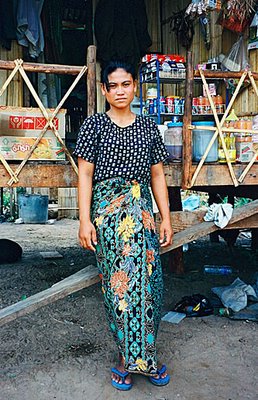 Shop-owner Kouch in the village of Kor Mouy at the foot of the mountain
Shop-owner Kouch in the village of Kor Mouy at the foot of the mountainThe
I was exhausted as I rested in the immigration hut next to a tiny pagoda. The two-hour climb had been a real challenge and when one of the monks suggested I wash in their natural bathing pool nearby, I gratefully accepted his offer. I stripped, retaining a krama around my waist for modesty, and ladled cold water from the large rock pool over my head and body, alongside three other monks and Sokhom. A westerner using their washing facilities was very uncommon they told us but they were pleased to share and I was happy to accept. Refreshed, we walked through the village and on through a narrow 200 metre channel marked by small white stones and red markers. Danger!! Mines!! signs were everywhere, though the deminers had retired to their homes for the evening. As we reached the crest of the mountain plateau, the wreckage of a military helicopter lay off to the left and directly in front of us the Cambodian flag fluttered above the first gopura of Preah Vihear temple. The gopura or entrance pavilion stands at the top of a steep stairway of 162 steps flanked by giant nagas that leads down to a small Khmer community who live just inside the border with
As I looked out towards a smooth tarmaced Thai motorway in the distance,
At 4am I was woken from my slumber by a cockerel that positioned itself a couple of metres away from my hammock and tested my eardrums to their full capacity with five loud crows. A carefully aimed training shoe temporarily halted the early morning alarm call, although a little over an hour later, he began again and on this occasion didn't stop. By that time, the heavens had opened and a thunderous downpour for forty minutes gave us a cool start to the day and filled up the water tanks and cooking pots with fresh water. It also brought with it a blanket of mist as we retraced our steps to the cliff top just after 6am. The low cloud completely concealed the view over northern Cambodia village of Kor Mouy
Before returning to our guesthouse, we headed for the Stung Sen river crossing, a kilometre north of the town centre, where children were splashing around in the shallow waters on large rubber tyres as the sun set in the background. I waded in to cool off, take a few pictures and watch the vehicles ford the river as they made their way north. After a refreshing shower with warmish water, we returned to Malop Dong where a minor disaster was averted - they had no chicken! - with a free pork dish as compensation. Kove's English was getting better with practice as we stopped by her stall for some delicious tikaloks and then back at the guesthouse, I met a couple of teachers from Phnom Penh, Srey Mom and Minit, who were instructing local schools in environmental studies, before retiring to bed a little after 9pm, at the end of a long and tiring day. I awoke at 6am after the best night's sleep of my whole trip and after noodles for breakfast with the teachers at Malop Dong - where the film Apocalypse Now was captivating the other diners - Sokhom and I were on our way. The slash and burn forestry technique was much in evidence for the first half of our return trip to Kompong Thom, with smouldering fields aplenty, despite the overnight rain, which had left puddles of dirty water everywhere. The Nissan pick-ups plying the route and the continuous stream of lorries carrying logs had done great damage to the road surface. We took a break at Prasat Kraham Chhouk, where the ceremonial bunting was the only reminder of the religious gathering two days earlier. The old laterite temple had been cleared of all vegetation and had lost some of its charm as a result, but it did make access to the structure a lot easier than on my previous visit in November. We stopped at Phnom Dek for a cold drink and I counted no less than five logging lorries parked up and three more sailed through whilst we took a breather and then at Chey, the turn-off for Sambor Prei Kuk, the cloud kicked up from the passing lorries as we sat sipping our coconuts covered everyone in a fine layer of red dust.
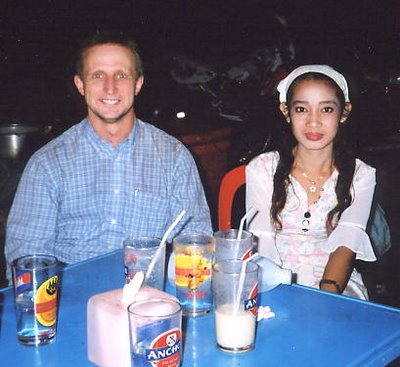 The author and Kove, the TBM queen of tikaloks
The author and Kove, the TBM queen of tikaloksOn the outskirts of Kompong Thom, children were clambering all over a couple of parked logging lorries, stripping the bark from the massive logs to use as firewood. It was 1.30pm as we entered the city centre - some six hours after leaving TBM - but our discoveries were not quite over. The infamous Khmer Rouge leader Pol Pot was born just four kilometres outside of the city centre, along the western bank of the Stung Sen river at a village called Prey Svai. As we arrived, a bunch of friendly children made a fuss of us, as Pol Pot's sister-in-law told us that his brother, who still lives in the house which overlooks the river, was having a siesta but she'd wake him if we wished to meet him. I declined, took a few photos of the house and the children and we returned to collect my bag from Sokhom's house and to book into my $10 air-con room at the Mittapheap Hotel, next to the river. I had two showers to remove the red dust from every nook and cranny and then slept soundly until Sokhom collected me at 6am. We visited his daughter's school, where she receives extra English lessons every evening and I was asked to take a class of 14-19 year olds by the female teacher. As it was an English class I invited them to ask me any questions they could think of, and although they were initially shy and reserved, a couple of the bolder students stood up and fired off a volley of questions ranging from 'what is your name?', to 'are you married?' and 'was I handsome?' I had to agree with the last question which sent the students into raptures of laughter. It was a bit of fun and maybe their endless repetition of my answers will in some small way improve their English pronounciation. Immediately after, I took Sokhom, Sroy and Kunthea, as well as Sroy's brother, Rit Noa to the Somrostbongcham restaurant for a slap-up meal that cost $10 in total, including four courses and endless drinks. It was back to Sokhom's home for tikaloks at a nearby stall and then back to my hotel for another 9pm turn-in. The following morning, I was up at 5.30am, showered, had breakfast at the Arunras and spent my last hour with Sokhom and his family before my share-taxi arrived at 8am to whisk me off to Phnom Penh Cambodia
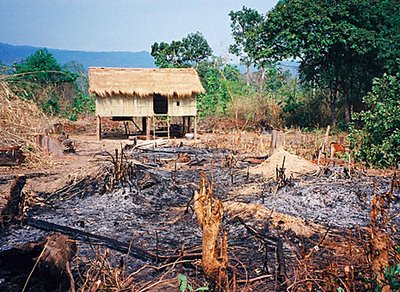 A new house on the route between Tbeng Meanchey and Kompong Thom
A new house on the route between Tbeng Meanchey and Kompong Thom
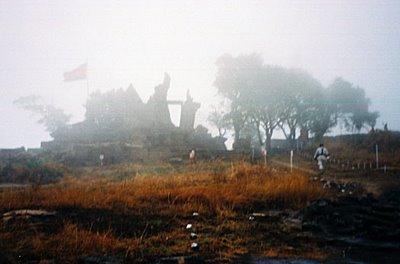
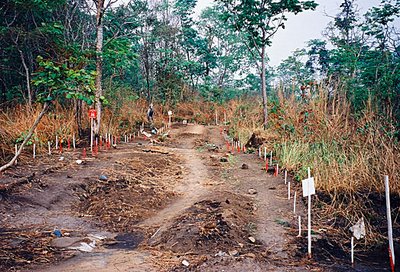
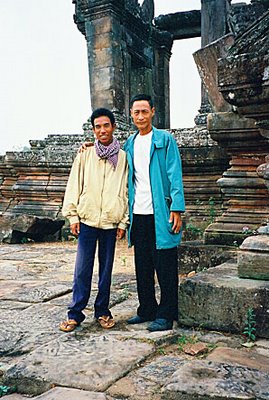
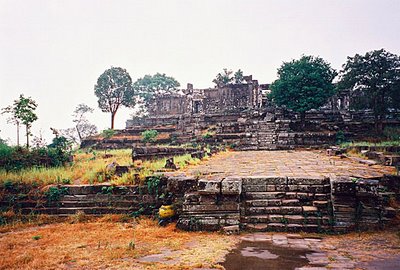
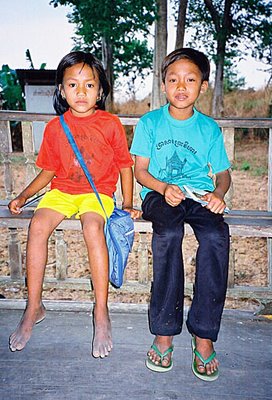
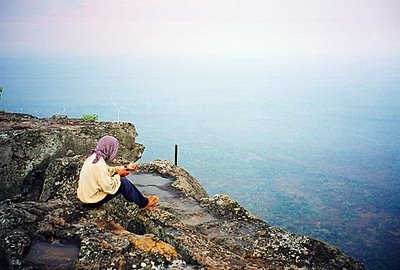
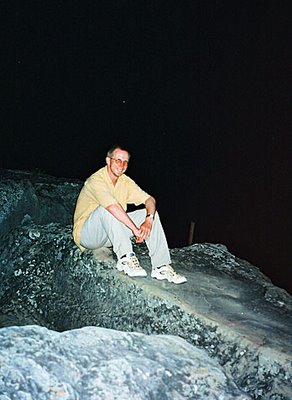
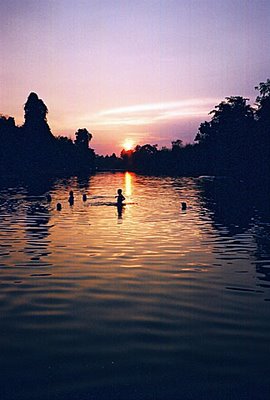


0 Comments:
Post a Comment
<< Home